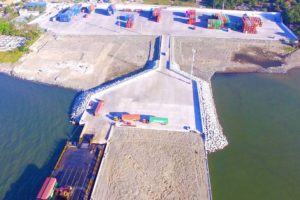
Manufacturers, especially exporters located in economic zones in Southern Luzon, can now take advantage of reduced travel time and lower logistics costs offered by Cavite Gateway Terminal (CGT) in Tanza, Cavite.
Built on a six-hectare property by port operator International Container Terminal Services, Inc. (ICTSI) at a cost of P1.5 billion, CGT is the country’s first roll-on/roll-off (RoRo) barge terminal launched in November 2018.
The common-use greenfield terminal can accommodate 115,000 twenty-foot equivalent units (TEUs), more than enough capacity to service the entire Cavite area which has an estimated demand for 100,000 TEUs.
At a recent forum on Trade Facilitation Initiatives in Southern Luzon, CGT general manager Reimond Silvestre said the terminal is a viable option to Metro Manila’s land infrastructure, which is in need of expansion to cater to the growing Philippine economy.
Other speakers at the forum were Trade Undersecretary Rowel Barba, Bureau of Customs spokesperson Atty Erastus Sandino Austria, and Cavite Economic Zone division chief Levi Vizmanos.
Silvestre said CGT basically aims to localize logistical requirements in Southern Luzon, especially Cavite.
By using the waterways, CGT allows Southern Luzon manufacturers and exporters to easily move their containers in and out of the Manila International Container Terminal (MICT), bypassing truck bans and the road congestion.

“We can transport containers to and from Manila more quickly than any truck can,” Silvestre said.
The full use of CGT is expected to help decongest Metro roads, reducing truck trips by an estimated 140,000 annually.
While CGT was initially conceptualized as a secondary transport option, the port operator “soon realized that the barge operation can actually be a standard mode of transportation,” Silvestre said.
Cavite economic zones are between 7 and 42 kilometers away from CGT, the closest being Suntrust Ecotown and Cavite Technopark.
Silvestre noted that traveling by land from these economic zones to and from Manila port may mean twice the distance and higher logistics costs due to road traffic congestion.
Another advantage of using CGT is that shipping services are safe, with barge operations between Manila and Cavite hardly affected by the unpredictable weather during the June to September monsoon season.
For exporters wanting to use the terminal, they may book directly with either of CGT’s barge operators, Bay Bridge Services and Harbor Star Shipping Services. The two operators each offer one sailing per day.
Silvestre said using the Tanza terminal guarantees that exporters will no longer have to worry about being shut out because “as soon as your export box is already inside the container yard at CGT, it is considered as if it is inside MICT.”
MICT is operated by CGT mother company ICTSI.

Exports using CGT have three days of free storage period, and another four free days in MICT.
For import cargoes, after the container has been cleared with the economic zone authority and Bureau of Customs (BOC) and terminal charges settled, the shipper can submit the gate pass to the CGT barge operator for the container to be loaded onto a barge.
Inclusive of the terminal fee, barge rates are the same or even lower than rates for trucking cargo from Manila to Cavite, Silvestre said.
CGT can also accommodate empty containers, but a pre-advice is necessary to ensure availability of a vessel that will evacuate the empty box after it is transferred to MICT.
CGT services also include empty container maintenance and repair for both dry and reefer boxes, container weighing, and other container-related services. The terminal can also handle special containers, out-of-gauge project cargoes, and ISO tanks. Equipment includes one empty handler, three reach stackers, two forklifts, and three prime movers.
